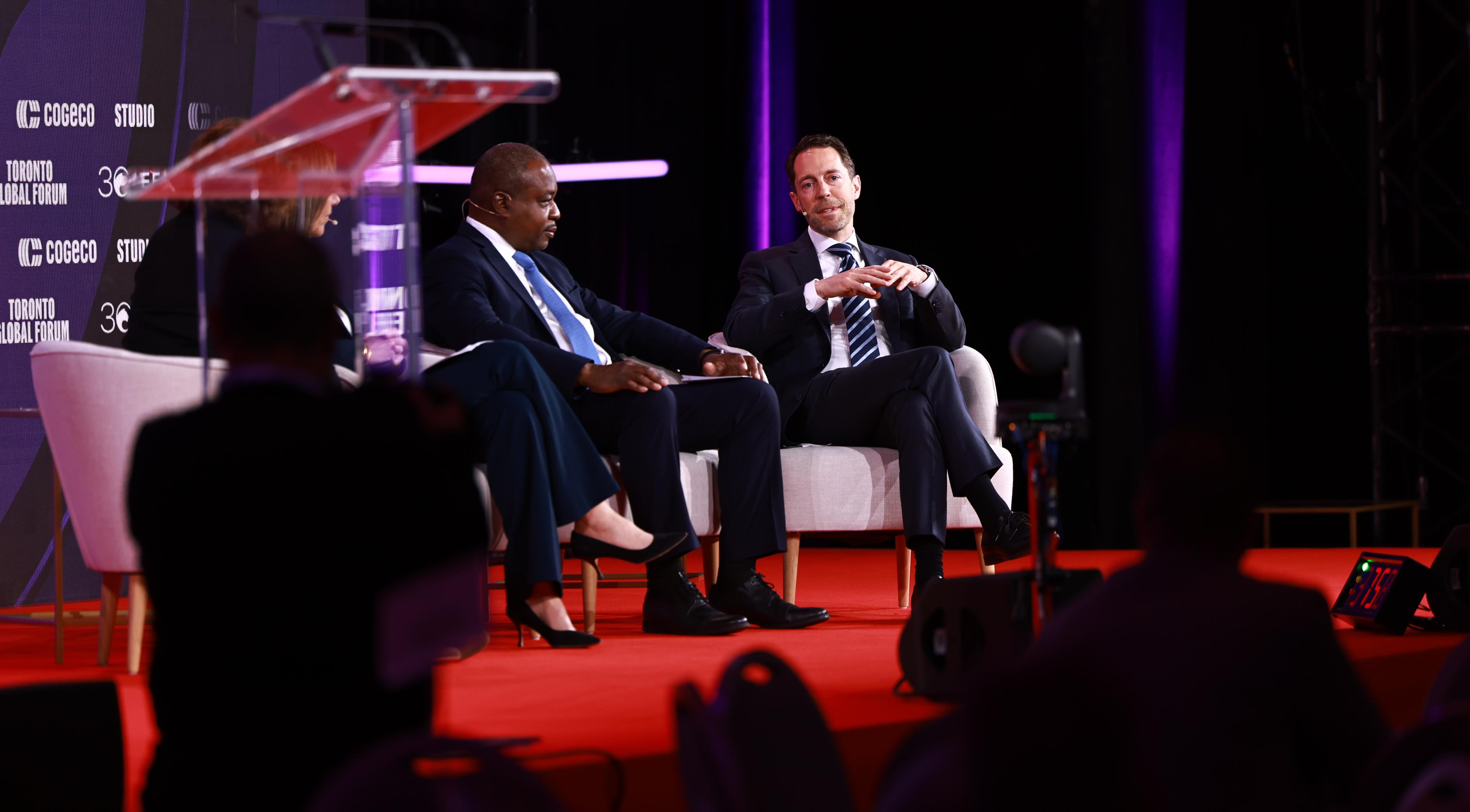
Building Infrastructure for the Future
-
bookmark
-
print



In a world where businesses seek to decarbonize and where our build environment will need to be more resilient than ever to withstand a more volatile physical risk environment, we cannot afford to fall short on our investments in critical infrastructure.
Identifying the challenges associated with building infrastructure for the future was the focus of the “Climate-Proofing Net Zero Infrastructure” panel I participated in at the 18th annual Toronto Global Forum, organized by the International Economic Forum of the Americas (IEFA).
Marie-Claude Dumas, the President and CEO of WSP Canada, and Macky Tall, Chair of Infrastructure Group at The Carlyle Group, joined me on the stage to unpack this important issue, with Karen Mazurkewich, Vice-President of Stakeholder Relations and Communications at Greater Toronto Airports Authority (GTAA), moderating the discussion.
Marie-Claude Dumas said it best when she discussed the need to consider infrastructure spending as an investment rather than an expense. As she pointed out, there is a cost for not doing it right. “Everyone understands that you can’t invest in infrastructure sporadically,” she said. “You need to make sure it’s not just about the cost of engineering construction, but also about the total cost of the asset and making sure you can operate and maintain it properly for its full life cycle.”
As we saw from the crippling effect of a water main break in Calgary earlier this year that forced the entire city to ration water use for weeks, we can’t afford to allow our infrastructure to erode. While that’s always been true, we also have to look to the future to meet our needs, such as the infrastructure demands to support electric vehicles (EVs).
Canada can be a world leader in EVs, but it needs to build the proper infrastructure to own this space. Slowing down investments in automakers and the infrastructure needed to support new vehicles will only give other countries an advantage.
An innovative approach to infrastructure
The Carlyle Group’s Macky Tall said innovation will play an essential role in how we get to a net-zero economy. “The reason we’re having this discussion is that the planet faces an existential threat, and so we have this obligation to migrate the world to a lower-carbon economy,” he explained. “That’s why these efforts have to be deployed across the infrastructure chain, and I would stress, in particular, the need for the energy transition to be successful.”
He added that Canada is in a solid position to help find sustainable infrastructure solutions. Continuing with the EV example, he noted that bidirectional charging technology, where EVs can give power back to the grid, is one area where utilities and municipalities need to start thinking creatively about how to bring this type of infrastructure to the public.
This solution, he explained, could help utilities manage the grid and consumption while also providing EV owners with a source of revenue that could offset the higher cost of their vehicles. Tall also discussed the need to think bigger outside of EVs, pointing to projects like carbon capture and storage, green hydrogen and sustainable aviation fuel.
There is a sense of urgency amongst businesses and governments around updating and upgrading our infrastructure. Between the energy transition and the development of new technologies such as artificial intelligence, global energy demand is increasing. High-carbon energy will remain a vital part of the energy mix for many years, explained Tall, which is why the world needs to invest in technology to capture and offset carbon production.
Canadian leadership
Here at BMO, we believe Canada is in an enviable position to be a leader, particularly in energy production. Quebec already has a 100% renewable energy grid, and we see how every effort to further electrify our economy leads to direct emissions reduction. Other provinces are also advancing rapidly in the deployment of tailored solutions to electrify and manage emissions.
Infrastructure of the future also includes entire new industries. Carbon Removal to net residual emissions and to restore the atmosphere to lower levels of CO2 will be required in all climate scenarios. This will require massive investments.
Canada has the potential to lead in this new industry, strong of its underground geological formations said to have sufficient capacity to store all of the CO2 the world has emitted. It’s not too bold to think that Canada can contribute to an important role in stabilizing and reversing climate change. The best way to make that happen is to foster innovation and empower entrepreneurs to find their wings and rapidly take the world stage while ensuring we have the right infrastructure to lead in carbon removal and carbon sequestration.
The role of private investment
As I noted during the conversation, government needs to be the enabler to set the stage to call for the right project, with the right level of innovation and the right parameters to ensure resilience in a future bound to differ from the past. But it would be a mistake not to leverage the private sector, especially now, given there is more private capital available than ever before. Of course, as we develop new styles of infrastructure, we encounter new technological risks and higher costs. The role of government to help minimize those risks will become even more important, especially when it comes to attracting private investment.
As Dumas from WSP Canada pointed out, everyone wants to be a responsible actor, but investors still want long-term returns. “The question of economics is very significant, and that’s where government comes in,” she said. “You can’t have a consortium that bids on a totally green way of building that’s so much more expensive that doesn’t deliver returns to investors.”
There will be a cost to building out our infrastructure for the future, but it will be far more expensive if we don’t make those investments. The challenge ahead may seem overwhelming and challenging, but the panelists shared their optimism for the future.
“I see a land of opportunity ahead of us,” said Tall. “It is a generational opportunity with so many investments – attractive investment opportunities across the sectors of energy, transport, building – and for many businesses for innovating around the energy space.”
Appointed President of BMO, Quebec and Vice Chair, BMO Capital Markets, in November 2022, Mr. Baillargeon has been with the Bank of Montreal since 2004. A trained l…(..)
View Full Profile >In a world where businesses seek to decarbonize and where our build environment will need to be more resilient than ever to withstand a more volatile physical risk environment, we cannot afford to fall short on our investments in critical infrastructure.
Identifying the challenges associated with building infrastructure for the future was the focus of the “Climate-Proofing Net Zero Infrastructure” panel I participated in at the 18th annual Toronto Global Forum, organized by the International Economic Forum of the Americas (IEFA).
Marie-Claude Dumas, the President and CEO of WSP Canada, and Macky Tall, Chair of Infrastructure Group at The Carlyle Group, joined me on the stage to unpack this important issue, with Karen Mazurkewich, Vice-President of Stakeholder Relations and Communications at Greater Toronto Airports Authority (GTAA), moderating the discussion.
Marie-Claude Dumas said it best when she discussed the need to consider infrastructure spending as an investment rather than an expense. As she pointed out, there is a cost for not doing it right. “Everyone understands that you can’t invest in infrastructure sporadically,” she said. “You need to make sure it’s not just about the cost of engineering construction, but also about the total cost of the asset and making sure you can operate and maintain it properly for its full life cycle.”
As we saw from the crippling effect of a water main break in Calgary earlier this year that forced the entire city to ration water use for weeks, we can’t afford to allow our infrastructure to erode. While that’s always been true, we also have to look to the future to meet our needs, such as the infrastructure demands to support electric vehicles (EVs).
Canada can be a world leader in EVs, but it needs to build the proper infrastructure to own this space. Slowing down investments in automakers and the infrastructure needed to support new vehicles will only give other countries an advantage.
An innovative approach to infrastructure
The Carlyle Group’s Macky Tall said innovation will play an essential role in how we get to a net-zero economy. “The reason we’re having this discussion is that the planet faces an existential threat, and so we have this obligation to migrate the world to a lower-carbon economy,” he explained. “That’s why these efforts have to be deployed across the infrastructure chain, and I would stress, in particular, the need for the energy transition to be successful.”
He added that Canada is in a solid position to help find sustainable infrastructure solutions. Continuing with the EV example, he noted that bidirectional charging technology, where EVs can give power back to the grid, is one area where utilities and municipalities need to start thinking creatively about how to bring this type of infrastructure to the public.
This solution, he explained, could help utilities manage the grid and consumption while also providing EV owners with a source of revenue that could offset the higher cost of their vehicles. Tall also discussed the need to think bigger outside of EVs, pointing to projects like carbon capture and storage, green hydrogen and sustainable aviation fuel.
There is a sense of urgency amongst businesses and governments around updating and upgrading our infrastructure. Between the energy transition and the development of new technologies such as artificial intelligence, global energy demand is increasing. High-carbon energy will remain a vital part of the energy mix for many years, explained Tall, which is why the world needs to invest in technology to capture and offset carbon production.
Canadian leadership
Here at BMO, we believe Canada is in an enviable position to be a leader, particularly in energy production. Quebec already has a 100% renewable energy grid, and we see how every effort to further electrify our economy leads to direct emissions reduction. Other provinces are also advancing rapidly in the deployment of tailored solutions to electrify and manage emissions.
Infrastructure of the future also includes entire new industries. Carbon Removal to net residual emissions and to restore the atmosphere to lower levels of CO2 will be required in all climate scenarios. This will require massive investments.
Canada has the potential to lead in this new industry, strong of its underground geological formations said to have sufficient capacity to store all of the CO2 the world has emitted. It’s not too bold to think that Canada can contribute to an important role in stabilizing and reversing climate change. The best way to make that happen is to foster innovation and empower entrepreneurs to find their wings and rapidly take the world stage while ensuring we have the right infrastructure to lead in carbon removal and carbon sequestration.
The role of private investment
As I noted during the conversation, government needs to be the enabler to set the stage to call for the right project, with the right level of innovation and the right parameters to ensure resilience in a future bound to differ from the past. But it would be a mistake not to leverage the private sector, especially now, given there is more private capital available than ever before. Of course, as we develop new styles of infrastructure, we encounter new technological risks and higher costs. The role of government to help minimize those risks will become even more important, especially when it comes to attracting private investment.
As Dumas from WSP Canada pointed out, everyone wants to be a responsible actor, but investors still want long-term returns. “The question of economics is very significant, and that’s where government comes in,” she said. “You can’t have a consortium that bids on a totally green way of building that’s so much more expensive that doesn’t deliver returns to investors.”
There will be a cost to building out our infrastructure for the future, but it will be far more expensive if we don’t make those investments. The challenge ahead may seem overwhelming and challenging, but the panelists shared their optimism for the future.
“I see a land of opportunity ahead of us,” said Tall. “It is a generational opportunity with so many investments – attractive investment opportunities across the sectors of energy, transport, building – and for many businesses for innovating around the energy space.”
2024 Toronto Global Forum
PART 1
Why Sustainability Is Good Business: Key Takeaways from IEFA Toronto 2024
Honourable Brian V. Tobin, P.C., O.C. | November 01, 2024 | Business Strategy

There is no shortage of challenges for governments and investors to deal with, including geopolitical risks, global warming and widening inequality b…
PART 3
Geopolitics and Gen AI: Is a Cybersecurity Storm Brewing?
Larry Zelvin | November 04, 2024 | Technology Banking, Business Strategy

Between the rise of artificial intelligence (AI) and geopolitical tensions, could a cybersecurity storm be brewing? The more business leaders can und…
Related Insights
Tell us three simple things to
customize your experience






Banking products are subject to approval and are provided in Canada by Bank of Montreal, a CDIC Member.
BMO Commercial Bank is a trade name used in Canada by Bank of Montreal, a CDIC member.
Please note important disclosures for content produced by BMO Capital Markets. BMO Capital Markets Regulatory | BMOCMC Fixed Income Commentary Disclosure | BMOCMC FICC Macro Strategy Commentary Disclosure | Research Disclosure Statements
BMO Capital Markets is a trade name used by BMO Financial Group for the wholesale banking businesses of Bank of Montreal, BMO Bank N.A. (member FDIC), Bank of Montreal Europe p.l.c., and Bank of Montreal (China) Co. Ltd, the institutional broker dealer business of BMO Capital Markets Corp. (Member FINRA and SIPC) and the agency broker dealer business of Clearpool Execution Services, LLC (Member FINRA and SIPC) in the U.S. , and the institutional broker dealer businesses of BMO Nesbitt Burns Inc. (Member Canadian Investment Regulatory Organization and Member Canadian Investor Protection Fund) in Canada and Asia, Bank of Montreal Europe p.l.c. (authorised and regulated by the Central Bank of Ireland) in Europe and BMO Capital Markets Limited (authorised and regulated by the Financial Conduct Authority) in the UK and Australia and carbon credit origination, sustainability advisory services and environmental solutions provided by Bank of Montreal, BMO Radicle Inc., and Carbon Farmers Australia Pty Ltd. (ACN 136 799 221 AFSL 430135) in Australia. "Nesbitt Burns" is a registered trademark of BMO Nesbitt Burns Inc, used under license. "BMO Capital Markets" is a trademark of Bank of Montreal, used under license. "BMO (M-Bar roundel symbol)" is a registered trademark of Bank of Montreal, used under license.
® Registered trademark of Bank of Montreal in the United States, Canada and elsewhere.
™ Trademark of Bank of Montreal in the United States and Canada.
The material contained in articles posted on this website is intended as a general market commentary. The opinions, estimates and projections, if any, contained in these articles are those of the authors and may differ from those of other BMO Commercial Bank employees and affiliates. BMO Commercial Bank endeavors to ensure that the contents have been compiled or derived from sources that it believes to be reliable and which it believes contain information and opinions which are accurate and complete. However, the authors and BMO Commercial Bank take no responsibility for any errors or omissions and do not guarantee their accuracy or completeness. These articles are for informational purposes only.
Bank of Montreal and its affiliates do not provide tax, legal or accounting advice. This material has been prepared for informational purposes only, and is not intended to provide, and should not be relied on for, tax, legal or accounting advice. You should consult your own tax, legal and accounting advisors before engaging in any transaction.
Third party web sites may have privacy and security policies different from BMO. Links to other web sites do not imply the endorsement or approval of such web sites. Please review the privacy and security policies of web sites reached through links from BMO web sites.
Please note important disclosures for content produced by BMO Capital Markets. BMO Capital Markets Regulatory | BMOCMC Fixed Income Commentary Disclosure | BMOCMC FICC Macro Strategy Commentary Disclosure | Research Disclosure Statements





